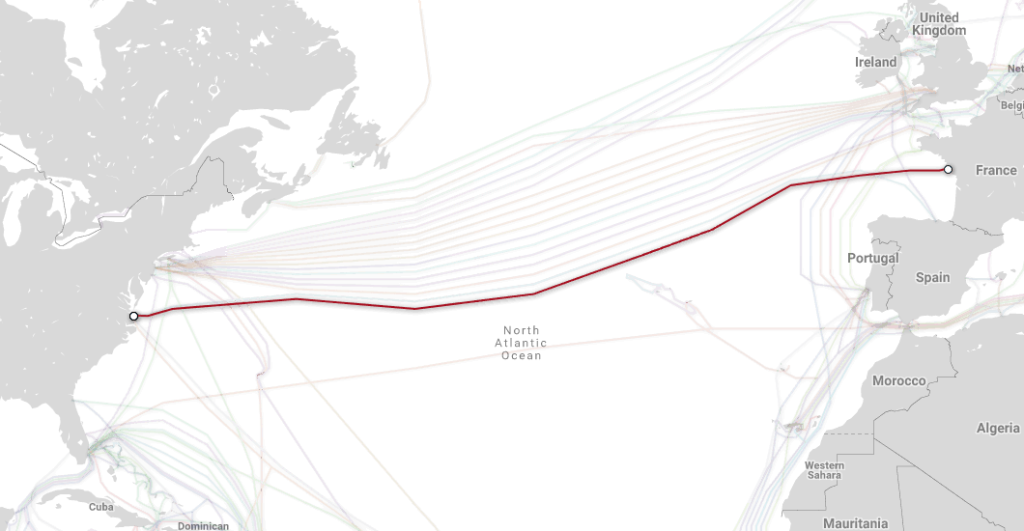News
Google Launches Its Dunant Subsea Cable Between The US And Europe

With Elon Musk’s Starlink satellites quickly filling up Earth’s orbit and promising low latency, broadband internet access to people living in the most remote corners of the world, it’s easy to forget that physical cables stretched across the ocean floor are still indispensable information super-highways.
Google, in partnership with telecommunications equipment company SubCom, has just announced the completion of one such super-highway between the United States and Europe. Called Dunant, this privately-owned subsea cable spans almost 4,000 miles (6,400 km) from Virginia Beach in the US to Saint-Hilaire-de-Riez, France, offering record-breaking data transfer capacity of 250 terabits per second (Tbps).

Submarine Cable Map
“We’re thrilled to say bonjour to the Dunant submarine cable system, which has been deployed and tested and is now ready for service,” writes Chris Ciauri, Google’s President for EMEA, in a blog post.
“The historic landing was made possible in partnership with SubCom, a global partner for undersea data transport, which engineered, manufactured, and installed the Dunant system on schedule despite the ongoing global pandemic.”
The two companies decided to name the subsea cable after Henry Dunant, a Swiss humanitarian, businessman, and social activist who received the first Nobel Peace Prize (together with Frédéric Passy) in 1901.
Google first announced the project in 2018 and expected to complete it in late 2020. The delay was caused by the COVID-19 pandemic. The tech giant, whose recent record quarterly revenues were largely caused by soaring cloud sales, is also working on a subsea cable between Portugal and South Africa, called Equiano.
Also Read: UAE Hope Probe To Go Into Orbit Around Mars This Week
“This new cable is fully funded by Google, making it our third private international cable after Dunant and Curie, and our 14th subsea cable investment globally,” stated Michael D. Francois, Tech Lead Manager of Global Network Infrastructure at Google. “Equiano will be the first subsea cable to incorporate optical switching at the fiber-pair level, rather than the traditional approach of wavelength-level switching.”
Both Dunant and Equiano are part of Google’s ongoing effort to improve its cloud network infrastructure and offer better reliability, speed, and security to its customers.
News
Alienware Just Announced Six New Gaming Monitors
The new models include three QD-OLED and three budget-friendly QHD options, expanding the company’s lineup for all gamers.

Alienware has just updated its gaming monitor lineup with six new additions, including the highly anticipated Alienware 27 4K QD-OLED Monitor. The latest wave of releases is set to reach more gamers than ever, offering high-end QD-OLED displays alongside more budget-friendly options.
The latest displays clearly show that the company is doubling down on QD-OLED with three new models sporting the technology. A redesigned Alienware 34 Ultra-Wide QD-OLED Monitor is also making a return, further refining what is already a fan-favorite display.
A Unified Design: The AW30 Aesthetic
All six monitors feature Alienware’s new AW30 design language, first introduced at CES. The AW30 aesthetic brings a futuristic, minimalist look that unites the entire lineup under a cohesive visual identity.
Pushing QD-OLED Even Further
The refreshed Alienware 34 Ultra-Wide QD-OLED Monitor (AW3425DW) builds on its predecessor’s success with a 240Hz refresh rate (up from 175Hz) and HDMI 2.1 FRL support. It also gains G-SYNC Compatible certification alongside AMD FreeSync Premium Pro and VESA AdaptiveSync, ensuring ultra-smooth performance. With a WQHD (3440×1440) resolution and an 1800R curve, this display enhances immersion for both gaming and cinematic experiences.
For those who crave speed, the Alienware 27 280Hz QD-OLED Monitor (AW2725D) pairs a high refresh rate with QHD resolution, balancing sharp visuals with ultra-smooth gameplay. Meanwhile, the Alienware 27 4K QD-OLED Monitor (AW2725Q) delivers stunning clarity with an industry-leading pixel density of 166 PPI, making it the sharpest OLED or QD-OLED monitor available.
Also Read: Infinite Reality Acquires Napster In $207 Million Deal
Worried about OLED burn-in? Alienware’s entire QD-OLED lineup comes with a three-year limited warranty covering burn-in concerns, offering peace of mind for gamers investing in these high-end displays.
Bringing QHD To A Wider Audience
Alongside QD-OLED, Alienware is also releasing three new QHD gaming monitors aimed at more price-conscious gamers. The Alienware 34 Gaming Monitor (AW3425DWM), Alienware 32 Gaming Monitor (AW3225DM), and Alienware 27 Gaming Monitor (AW2725DM) provide a range of sizes and formats to suit different preferences:
- The Alienware 34 Gaming Monitor (AW3425DWM): An ultrawide (WQHD) option for a panoramic, immersive experience.
- The Alienware 32 Gaming Monitor (AW3225DM): A standard 16:9 panel for a traditional but expansive desktop setup.
- The Alienware 27 Gaming Monitor (AW2725DM): A 27” display offering the same performance in a more compact form factor.
All three gaming monitors feature a fast 180 Hz refresh rate, a 1ms gray-to-gray response time, and support for NVIDIA G-SYNC, AMD FreeSync, and VESA AdaptiveSync to eliminate screen tearing. Additionally, with 95% DCI-P3 color coverage and VESA DisplayHDR400 certification, these displays deliver vibrant colors and high dynamic range for lifelike visuals.



























